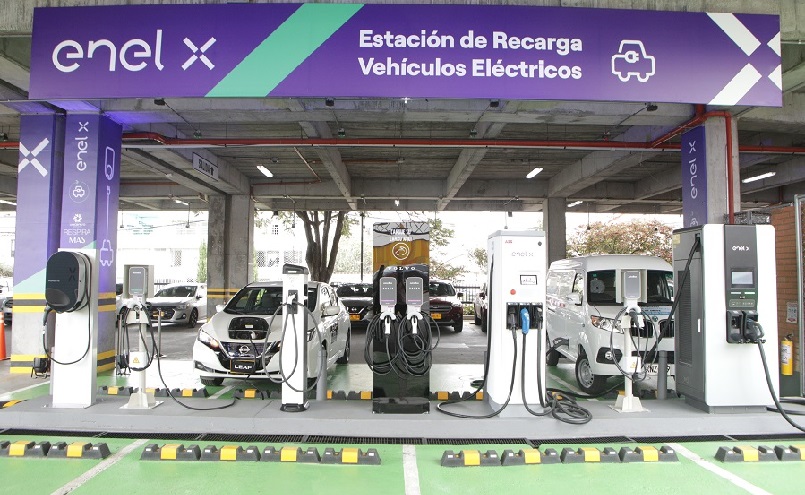Enel X, the leading electric mobility company with a presence throughout Latin America, presents its development plans for Chile, Colombia, Brazil, and Peru.
They did so at the “Enel X Day,” organized by Mobility Portal Latinoamérica, an event to address electromobility trends in the region.
What are they working on?
Chile
“We already have more than 540 active public chargers and, additionally, we will install more than 800 chargers in total,” says Marcela Díaz, Head of Marketing and Sales e-mobility Chile.
In Chile, Enel X is working on “decentralising” electric mobility and aims to understand their customers’ needs when it comes to charging their electric vehicles.
Currently, nearly 80% of the charging infrastructure is located in the Metropolitan region, but in other regions, it represents only 10% of the demand.
“We already offer 20% of the public charging infrastructure. We are taking a step further by bringing these services to different regions of the country,” she says.
Díaz states that this has been a “fruitful” year, with a notable increase in the availability and accessibility of electric vehicles.
Brands are expanding their offerings, with prices approaching 15,000 dollars, positioning this segment among the top two places in electric vehicle sales in Chile.
The participation of electric and plug-in hybrid vehicles will increase from 1.2% to 5% by the end of 2025.
In the long term, the aspiration is for 100% of vehicles in Chile to be electric by 2035.
“We are developing private charging applications and services that integrate both private and public options to ensure the continuity of this attribute that distinguishes us,” she comments.
Colombia
Mauricio Miranda, manager of e-mobility Colombia, elaborates on the success story at Unicentro, one of the region’s most popular hubs.
Unicentro is a shopping mall of approximately 100,000 square meters, with 3,200 parking spaces and around 45,000 daily visitors.
“Its electrical infrastructure, which supports this entire operation, was an open-air, live laboratory,” he comments.
The business model began eleven years ago, with two 7-kilowatt chargers to start the electric taxi pilot: “It took us four months to install these two chargers and bring in the imported fast charger.”
Once the 50-kilowatt fast charger arrived, taxi drivers began using it, which helped observe charging times and management needs.
The creation of an app allowed taxi drivers to schedule their charges, optimising the use of fast chargers and enabling efficient management of available resources.
The initial success led to the expansion of the infrastructure, including three additional slow chargers and one fast charger, which began to serve not only taxis but also private vehicles and last-mile delivery fleets.
“We realised this model could work well and removed barriers and difficulties for corporate and private fleets,” explains Miranda.
The acceptance and collaboration of Unicentro were crucial for developing a public charging infrastructure in private spaces.
Initially, the charging services were free, which resulted in problems with users leaving their vehicles for long periods.
To solve this, Enel X began charging for the service, adjusting rates according to usage time, occupied space, and energy supplied.
Currently, the infrastructure includes 13 slow chargers of 7 kW and a 150 kW GBT charger.
The partnership with Unicentro not only allowed the implementation of chargers but also the creation of a joint venture for public charging.
“Vehicle brands are buying our chargers. We install them and generate a joint venture for public charging, not exclusively for the brands’ customers,” highlights Miranda.
Brazil
Enel X has inaugurated its first charging centre in São Paulo, strategically located in the parking area of Shopping SP Market, on Avenida das Nações Unidas.
This new charging station offers a practical and efficient solution for electric car owners, with the capacity to charge up to 20 vehicles simultaneously.
To plan its development, the company conducted an analysis to identify areas with unmet demand for charging fleets and application-based vehicles.
“We analysed vehicle flow and needs using heat maps of fleet movement,” details Jorge Cernadas, Marketing and Sales Manager for Electromobility in Latin America.
Situated in a 230 m² space, the hub not only provides easy access for drivers due to its position on one of the city’s busiest roads but also fills a significant gap in the South Zone, a region lacking similar services.
The hub can charge 20 electric cars in parallel, with an installed power of approximately 200 kilowatts.
“It’s a collaborative effort, not just with the companies that will use the hub, but also with the shopping centre’s engineers to understand electrical availability and reinforcement needs,” adds Cernadas.
Payment can be made through the app indicated in the instructions next to the chargers.
“The interesting aspect of the system we developed with our technology partner is that it allows for the inclusion of other payment managers in the same charger,” he notes regarding the method that enables vehicle charging using different payment applications.
Peru
Recently, Enel X developed charging infrastructure at the South Dock of the Port of Callao, making it the first port terminal in Latin America to have this type of infrastructure.
The initiative, part of a strategic alliance with DP World, the concessionaire of the South Dock, allows for clean energy charging for a fleet of twenty electric trucks for internal transport.
In dialogue with Mobility Portal Latinoamérica, Alex Ascón, Head of e-mobility Peru, comments that the joint work with DP World began in 2021 with advisory tasks.
“We focused on identifying what their route was towards 2030, as a project of this magnitude would help them get closer to their goals, aware that time flies,” he explains.
The project was awarded at the end of 2022, and immediately, implementation began.
“It was crucial that the stakeholders were clear that electric mobility technology, in this case, the chargers and all the port development, was the right one. They were already convinced of the technology,” he indicates.
At this point, he argues that many projects sometimes take longer than usual because they do not have a well-defined concept.
Thus, they moved on to the next stage, starting with engineering and charger specification.
The next phase involved charger design and specification, with the particularity that they would not be installed in an urban location but in a maritime environment.
“It was an additional challenge, as we had to identify the materials and conditions to which the chargers would be subjected during their extended operation, as well as the daily operation of a port for trucks,” adds Ascón.
The project was realized to operate with twenty trucks, using ten fast chargers with a double European socket. Additionally, buses and vans are incorporated, operating and charging at the same charging point at the Port of Callao.
“Our additional challenge as a company is to bring this same technology to the rest of the ports in Latin America,” he emphasizes.
And he adds, “On a global level, we could also implement this technology, leveraging the knowledge and experience gained in Peru.”







